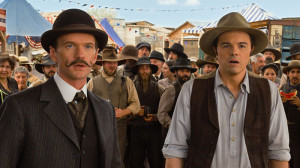There’s a scene in Seth MacFarlane’s animated sitcom, Family Guy, in which the precocious baby Stewie attempts to get his mom’s attention through a solid 30 seconds of just repeating her name or variations on the word “Mom.” That’s the whole joke: A kid just keeps repeating essentially the same word for 30 seconds until he wears her down, and then he doesn’t have anything more to say then “hi” once he finally gets her attention.
That’s MacFarlane’s A Million Ways to Die in the West in a nutshell: A constant assault of repetitive jokes designed to wear the viewer down, without much to say in the end.
What’s frustrating about MacFarlane — who writes, directs and stars in this Western about Albert, a cowardly sheep farmer who inadvertently falls in love with the wife (Charlize Theron) of a dangerous outlaw (Liam Neeson) — is that sometimes, maybe even as much as half the time, he actually is legitimately funny. There are subtle, smart jokes scattered throughout the film, but they tend to get drowned by the bleating volume of lazy jokes about bodily functions, racial and gender stereotypes and learning-disabled sheep. The problem isn’t that the jokes are crass; they’re just not that funny.
MacFarlane’s obvious touchstone here is another western comedy that was both crass and smartly provocative, Mel Brooks’ 1974 Blazing Saddles. Like Brooks, MacFarlane attempts to hit satirical hot buttons, making jokes at the expense of racists and the closed-minded, and employing strategic anachronisms and fourth-wall breaking to help make points about the ridiculousness of old-fashioned attitudes.

9(MDAxOTAwOTE4MDEyMTkxMDAzNjczZDljZA004))

